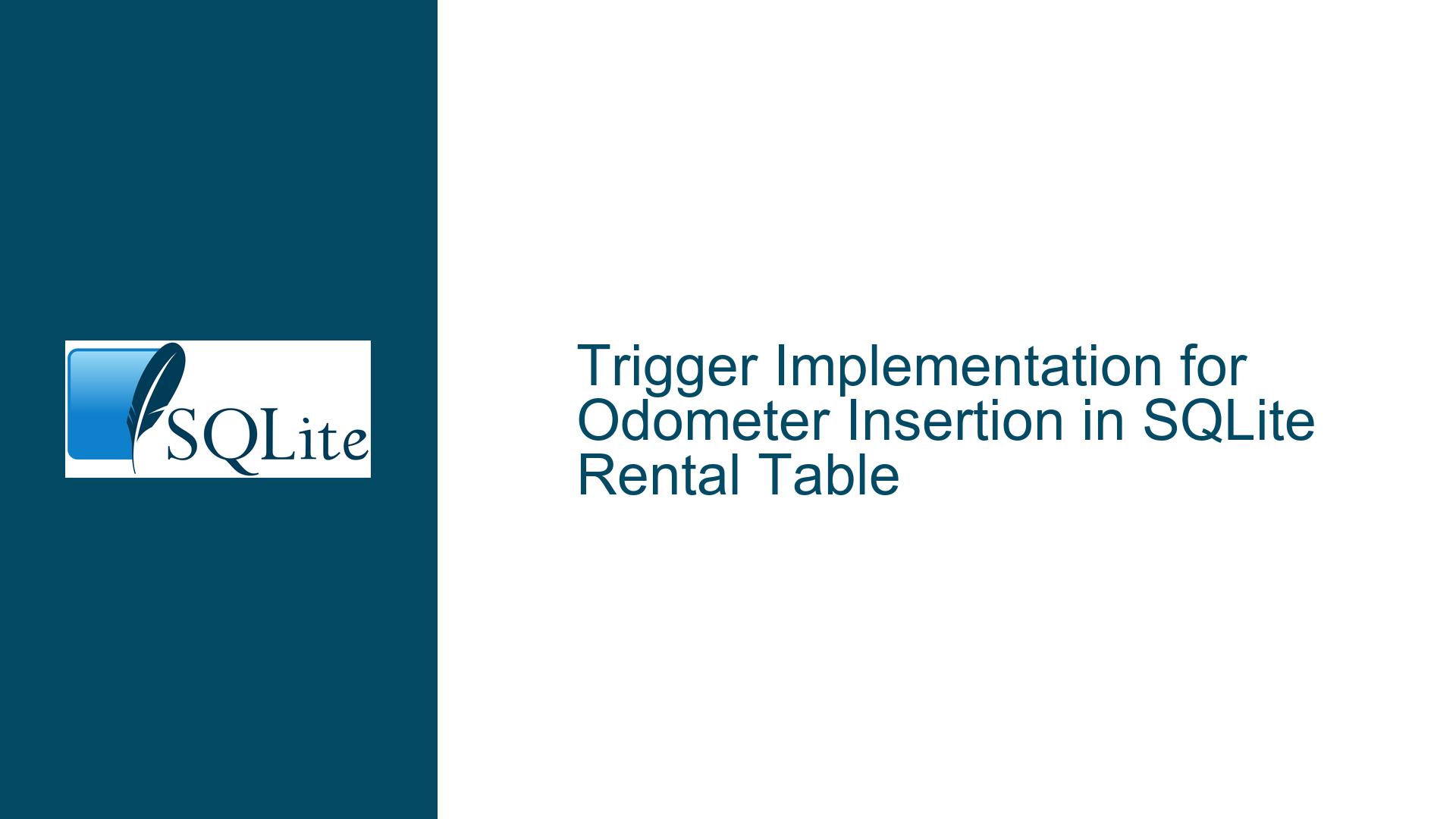Trigger Implementation for Odometer Insertion in SQLite Rental Table
Odometer Data Not Automatically Inserted into Rental Table
The core issue revolves around the need to automatically insert the odometer reading from the Vehicle table into the Rental table whenever a new rental record is created. The current schema defines two tables: Vehicle and Rental. The Vehicle table contains details about vehicles, including the odometer reading, while the Rental table tracks rental transactions, including the odometer readings at the start and end of the rental period. The challenge is to ensure that the odometer reading from the Vehicle table is automatically inserted into the Rental table’s odo_out column when a new rental record is created.
The schema definitions reveal that the Vehicle table has a primary key on the VIN (Vehicle Identification Number), which is also a foreign key in the Rental table. This relationship is crucial for ensuring data integrity and enabling the trigger to fetch the correct odometer reading. However, the current setup lacks a mechanism to automatically populate the odo_out column in the Rental table with the odometer reading from the Vehicle table when a new rental record is inserted.
Incorrect CHECK Constraints and Trigger Logic
One of the primary causes of the issue lies in the schema design, particularly the CHECK constraints and the absence of a trigger to automate the odometer insertion. The CHECK constraints in the Vehicle table are intended to enforce specific rules on the VIN, such as its length, case, and character composition. However, the current implementation of these constraints is problematic.
The CHECK constraint for the third character of the VIN is overly verbose and could be simplified for better readability and maintainability. Instead of using multiple OR conditions, the constraint could be rewritten using the IN operator, which would achieve the same result in a more concise manner. Additionally, the CHECK constraint that prohibits certain characters (‘I’, ‘O’, ‘Q’) in the VIN is logically flawed. The current implementation uses OR conditions, which means the constraint will only fail if all three characters are present in the VIN. This is likely not the intended behavior, as the goal is presumably to exclude any VIN that contains any of these characters. The correct approach would be to use AND conditions to ensure that the VIN does not contain any of the prohibited characters.
Another significant issue is the absence of a trigger to automate the insertion of the odometer reading from the Vehicle table into the Rental table. Without this trigger, the odometer reading must be manually specified in the INSERT statement, which is error-prone and inefficient. The trigger should be designed to fire upon the insertion of a new record into the Rental table, fetching the corresponding odometer reading from the Vehicle table based on the VIN and inserting it into the odo_out column.
Implementing a Trigger and Correcting CHECK Constraints
To resolve the issue, the first step is to correct the CHECK constraints in the Vehicle table. The constraint for the third character of the VIN should be simplified using the IN operator, and the constraint for prohibited characters should be corrected to use AND conditions. Here is the revised schema for the Vehicle table:
CREATE TABLE Vehicle(
carMake TEXT NOT NULL,
carModel TEXT NOT NULL,
carYear INTEGER NOT NULL,
VIN TEXT NOT NULL,
odometer INTEGER NOT NULL,
PRIMARY KEY (VIN),
CHECK (length(VIN) == 5),
CHECK (UPPER(VIN) == VIN),
CHECK (SUBSTR(VIN,3,1) IN ('X', '0', '1', '2', '3', '4', '5', '6', '7', '8', '9')),
CHECK (VIN NOT LIKE '%I%' AND VIN NOT LIKE '%O%' AND VIN NOT LIKE '%Q%')
);
Next, a trigger must be created to automatically insert the odometer reading from the Vehicle table into the Rental table when a new rental record is inserted. The trigger should be designed to fire after the INSERT operation on the Rental table. Here is the SQL statement to create the trigger:
CREATE TRIGGER insert_odometer
AFTER INSERT ON Rental
FOR EACH ROW
BEGIN
UPDATE Rental
SET odo_out = (SELECT odometer FROM Vehicle WHERE VIN = NEW.VIN)
WHERE VIN = NEW.VIN AND customerID = NEW.customerID AND date_out = NEW.date_out;
END;
This trigger works as follows: After a new record is inserted into the Rental table, the trigger fires and updates the odo_out column in the newly inserted record with the odometer reading from the Vehicle table. The trigger uses a subquery to fetch the odometer reading based on the VIN of the newly inserted rental record. The WHERE clause ensures that only the newly inserted record is updated, preventing unintended modifications to other records.
To ensure that the trigger functions correctly, it is essential to test it with various scenarios. For example, inserting a new rental record with a valid VIN should result in the odo_out column being populated with the correct odometer reading from the Vehicle table. Additionally, inserting a rental record with an invalid VIN should result in an error, as the foreign key constraint will prevent the insertion.
Here is an example of an INSERT statement that should work correctly with the trigger in place:
INSERT INTO Rental (customerID, VIN, date_out) VALUES (1, 'A0X2Z', '2020-09-24');
After executing this statement, the odo_out column in the newly inserted record should be populated with the odometer reading from the Vehicle table for the vehicle with VIN ‘A0X2Z’.
In conclusion, the issue of automatically inserting the odometer reading from the Vehicle table into the Rental table can be resolved by correcting the CHECK constraints in the Vehicle table and implementing a trigger to automate the insertion process. The revised schema and trigger ensure data integrity and efficiency, reducing the risk of errors and manual intervention. By following these steps, the database will be better equipped to handle rental transactions accurately and efficiently.






